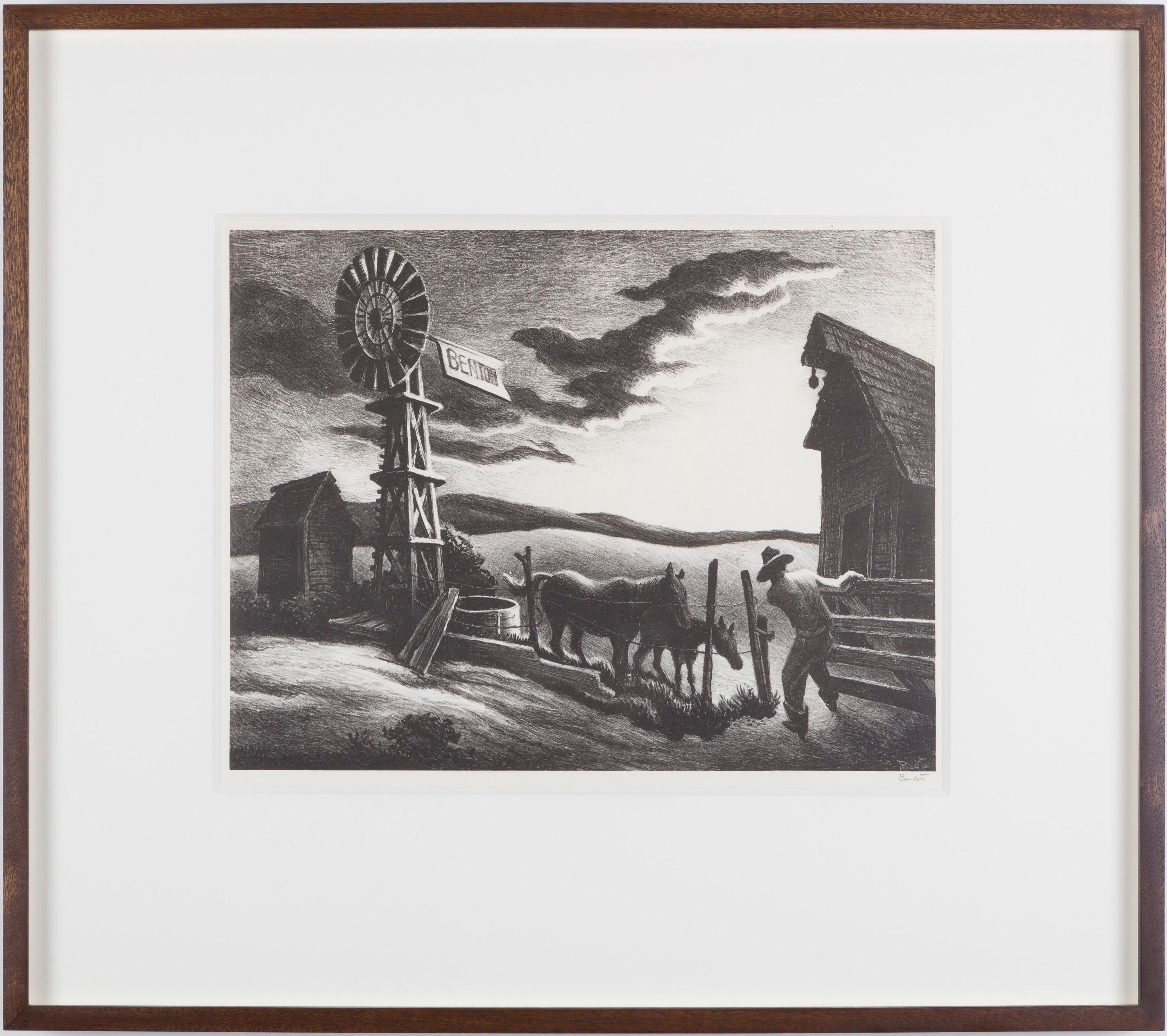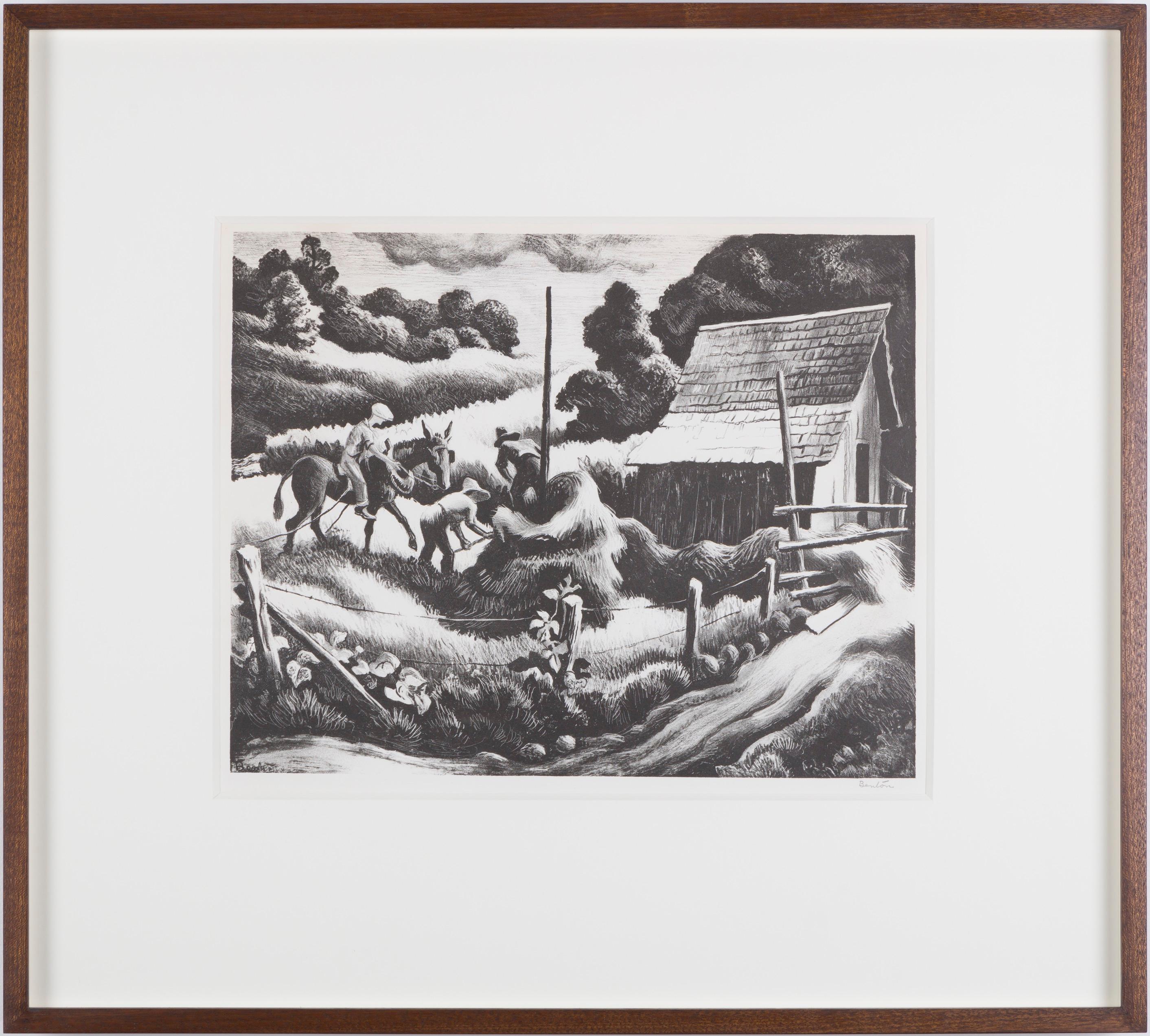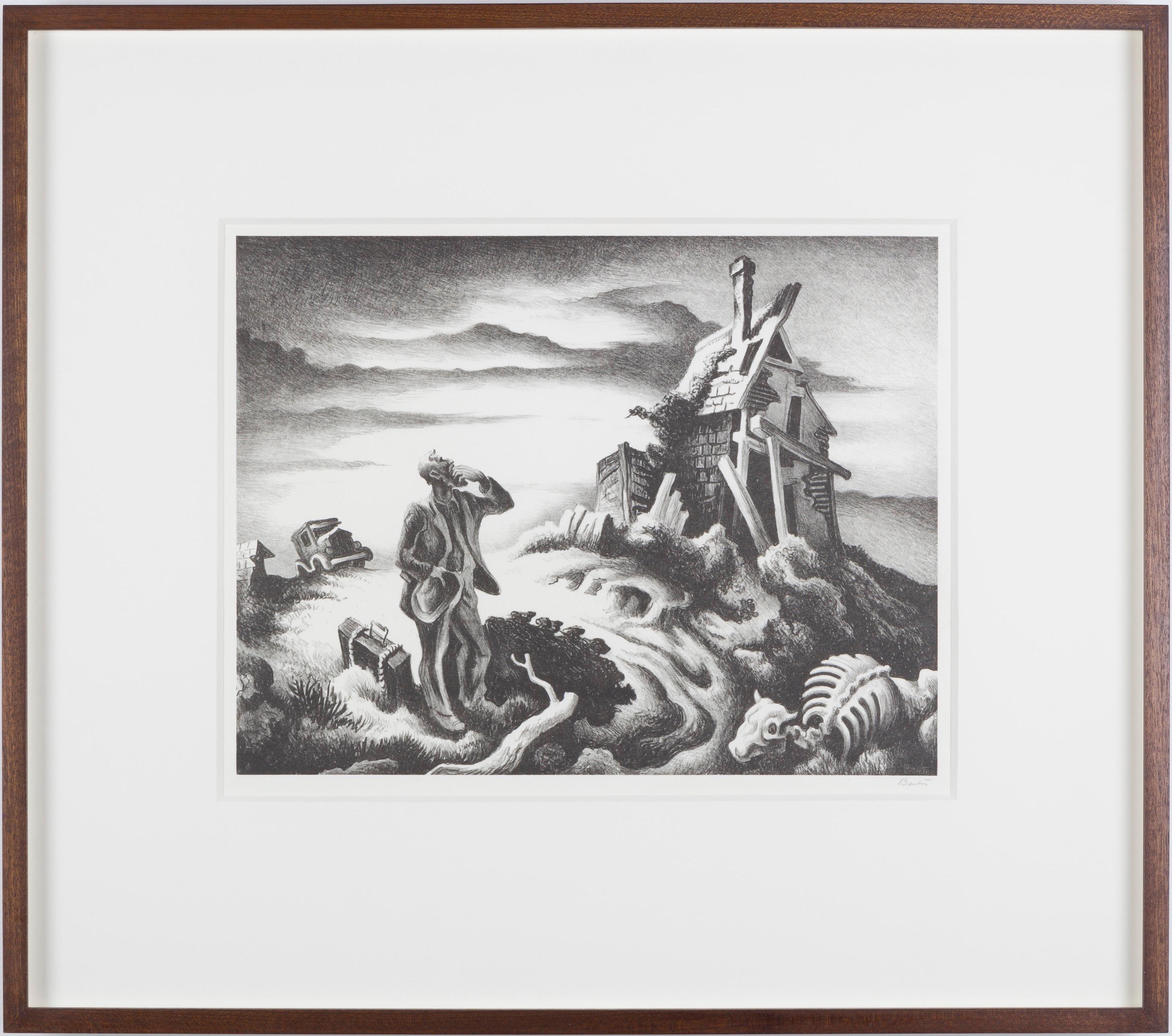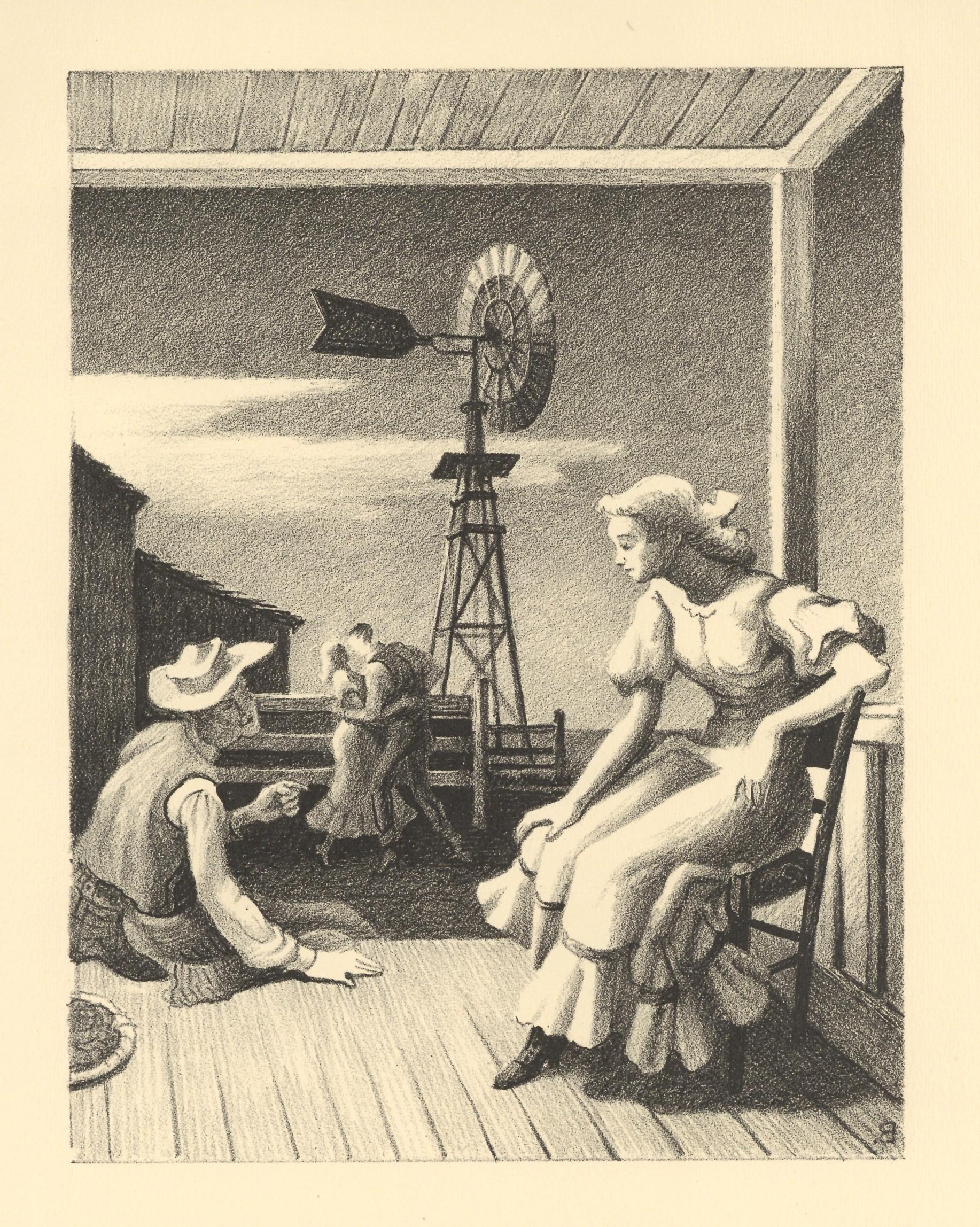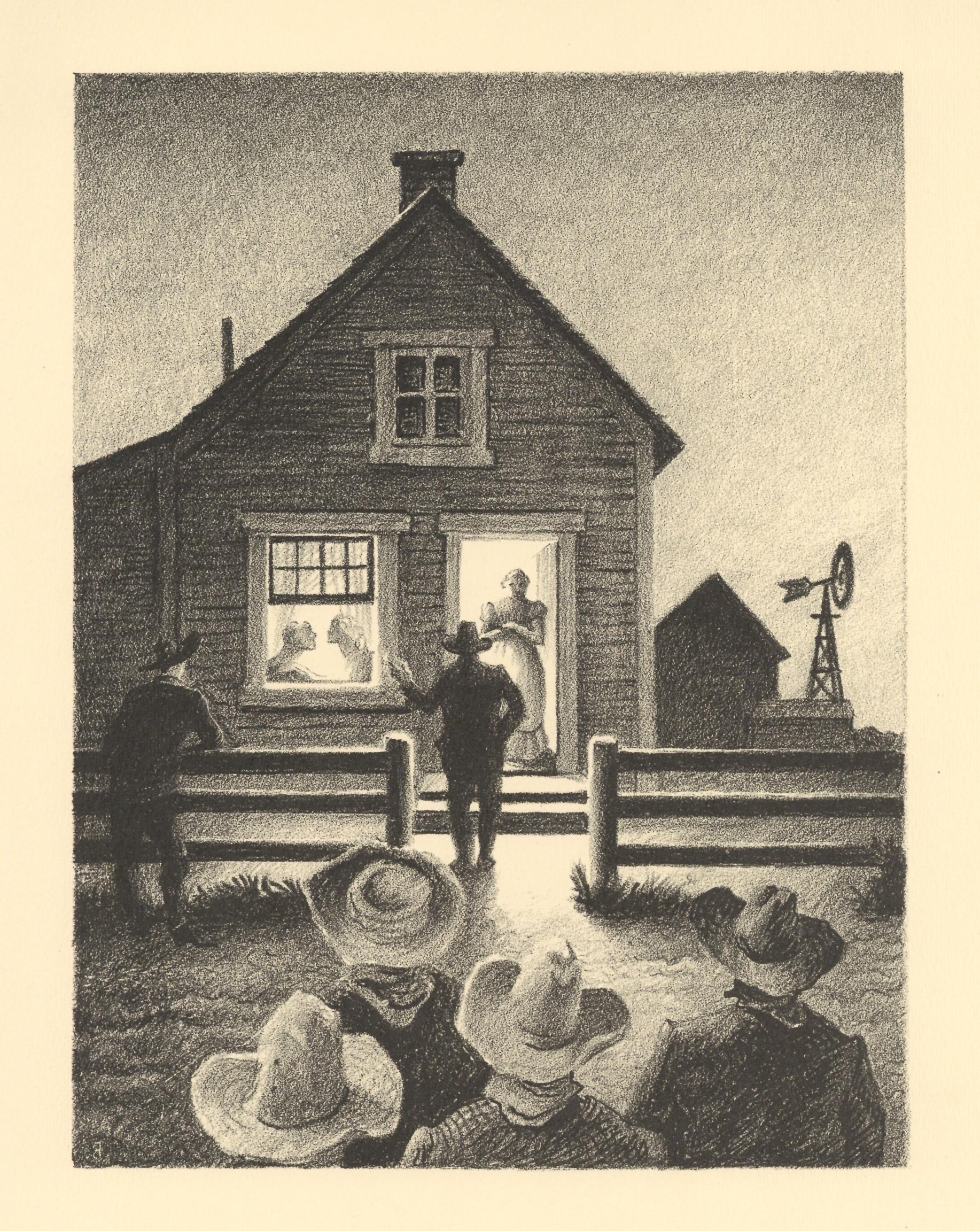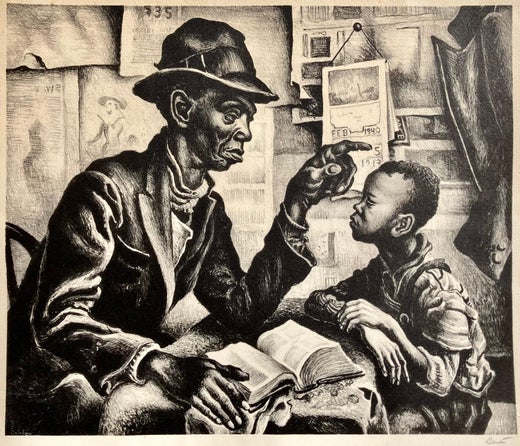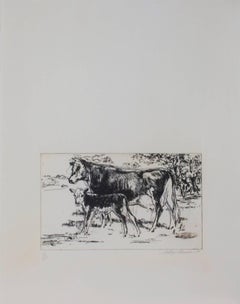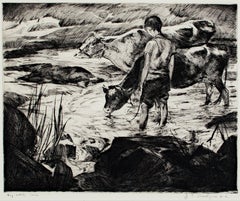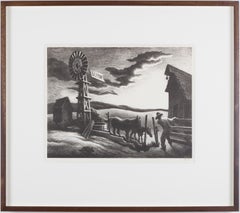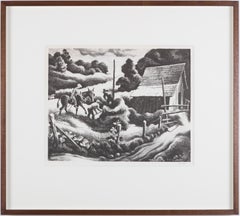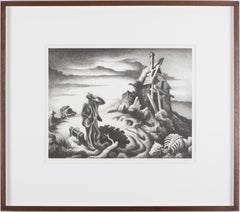Items Similar to "White Calf, " Farm Genre Scene Original Lithograph by Thomas Hart Benton
Want more images or videos?
Request additional images or videos from the seller
1 of 10
Thomas Hart Benton"White Calf, " Farm Genre Scene Original Lithograph by Thomas Hart Benton1945
1945
$5,075
£3,845.28
€4,412.15
CA$7,141.34
A$7,850.30
CHF 4,125.76
MX$95,331.26
NOK 51,467.80
SEK 48,762.12
DKK 32,928.98
About the Item
"White Calf" is an original lithograph print by Thomas Hart benton. It features the image of a man milking a cow while her calf lays down in front. Benton's breathtaking way of rendering landscape is shown here in the way the grass covers the ground like waves in the ocean.
Image: 9.75" x 12.63"
Framed: 18.13" x 20.88"
Thomas Hart Benton was one of America's most popular and heavily patronized modern artists during the decades leading up to World War II, and his murals were especially acclaimed. Along with Grant Wood and John Steuart Curry, Benton gained artistic fame as a Regionalist painter, depicting the people and culture of the American Midwest, in particular his native state of Missouri. While his subjects were primarily based in America's heartland, he lived in New York City for twenty years. Considered by many to be reactionary due to his outspoken and inflammatory diatribes against the art world, Benton, a populist, did in fact boldly use his art to protest the KKK, lynching, and fascism during the 1930s and 1940s. Benton was also an admired teacher at New York's Art Students League, offering students grounding in European art history, as well as an awareness of European modernism. The advent of Abstract Expressionism has all but eclipsed Benton's importance in the history of modern art. Benton's main contribution to twentieth-century American art might be his thematic emphasis on images of ordinary people and common lore. His expressive realism stands out for its exaggerated curvilinear forms and shapes, and bold use of key colors. By shifting attention away from New York and towards the Midwest, Benton expanded both the scope of possible artistic subject matter, and the potential public for American art. In his paintings and prints, Benton was devoted to the evocations of sound and music as a method of communication. His interest in sound, often vernacular songs and instruments, as well as stump-speeches and dialogue, can be seen as relating back to his family's history in Missouri politics, where one often spoke of the voice of the people; Benton sought to keep this popular voice alive in his artwork. The artist, a self-taught and often performing harmonica player, was also a collector, cataloguer, transcriber, and distributor of popular music. By the mid-1940s, Benton became infamous for his outlandish claims against art critics and museums, at one point going on a homophobic rant. With his strong ego and stubbornness, Benton became a rather isolated persona-non-grata, even amongst his own field. Jackson Pollock was Benton's most ardent follower in the 1930s and his early work bears a strong similarity to that of his teacher in terms of style and subject matter. Rather than a complete break from Benton, Pollock's move towards pure abstraction is best seen as an aesthetic shift. The shift from Regionalism to Abstract Expressionism can also be read in relation to a broader cultural and political shift from New Deal reformist politics, to the Cold War post-atomic age.
- Creator:Thomas Hart Benton (1889-1975, American)
- Creation Year:1945
- Dimensions:Height: 18.13 in (46.06 cm)Width: 20.88 in (53.04 cm)
- Medium:
- Movement & Style:
- Period:
- Condition:
- Gallery Location:Milwaukee, WI
- Reference Number:Seller: 12335c1stDibs: LU60534933541
Thomas Hart Benton
Thomas Hart Benton was born in Neosho, Missouri on April 15, 1889. Even as a boy, he was no stranger to the "art of the deal" or to the smoke-filled rooms in which such deals were often consummated. His grandfather had been Missouri's first United States Senator and served in Washington for thirty years. His father, Maecenas Benton, was United States Attorney for the Western District of Missouri under Cleveland and served in the United States House of Representatives during the McKinley and Theodore Roosevelt administrations. Benton's brother, Nat, was prosecutor for Greene County, Missouri, during the 1930s. As soon as he could walk, Benton traveled with his father on political tours. There he learned the arts of chewing and smoking, and while the men were involved in their heated discussions, Benton delighted in finding new cream colored wallpaper on the staircase wall, at the age of six or seven, and drew in charcoal his first mural, a long multi-car freight train. As soon as he was eighteen, even though his father wanted him to study law, Benton left for Chicago where he studied at the Art Institute during the years 1907 and 1908. He continued his studies in Paris, where he learned delicious wickedness, aesthetic and otherwise. Once back home, he became the leader of the Regionalist School, the most theatrical and gifted of the 1930s muralists and as Harry Truman described him,"the best damned painter in America." Detractors said that Benton was "a fascist, a communist, a racist and a bigot"; the ingenious structure, powerful use of modeling and scale and the high-colored humanity of the murals and easel paintings are retort enough. He was a dark, active dynamo, only 5 ft., 3 1/2 in. tall. He was outspoken, open, charmingly profane; he had a great mane of hair and a face the texture of oak bark. He wore rumpled corduroy and flannel, and walked with the unsteady swagger of a sailor just ashore. He poured a salwart drink, chewed on small black cigars and spat in the fire. Benton was once described as the "churlish dean of regionalist art." If you listened to a variety of art authorities, you would find them equally divided between Harry Truman's assessment of Benton as "the best damned painter in America" and Hilton Kramer who proclaimed Benton "a failed artist." The East Coast art establishment tended to regard Benton as memorable for one reason only: he was the teacher of Jackson Pollock. Benton was married in 1922 to Rita, a gregarious Italian lady, and they had a daughter and a son. At the height of his fame in the 1940s, Benton bungled the buy-out he was offered by Walt Disney and went his own way, completing his last mural in 1975 in acrylics the year of his death. He died in 1975.
About the Seller
4.9
Platinum Seller
Premium sellers with a 4.7+ rating and 24-hour response times
Established in 1966
1stDibs seller since 2017
447 sales on 1stDibs
Typical response time: 3 hours
- ShippingRetrieving quote...Shipping from: Milwaukee, WI
- Return Policy
Authenticity Guarantee
In the unlikely event there’s an issue with an item’s authenticity, contact us within 1 year for a full refund. DetailsMoney-Back Guarantee
If your item is not as described, is damaged in transit, or does not arrive, contact us within 7 days for a full refund. Details24-Hour Cancellation
You have a 24-hour grace period in which to reconsider your purchase, with no questions asked.Vetted Professional Sellers
Our world-class sellers must adhere to strict standards for service and quality, maintaining the integrity of our listings.Price-Match Guarantee
If you find that a seller listed the same item for a lower price elsewhere, we’ll match it.Trusted Global Delivery
Our best-in-class carrier network provides specialized shipping options worldwide, including custom delivery.More From This Seller
View All20th century etching animal print black and white cows farm scene sketch signed
By LeRoy Neiman
Located in Milwaukee, WI
"Bovine Family" is an original etching by Leroy Neiman. The artist signed the piece lower left. It is edition 182/250 and dated 1980. It depicts a cow an...
Category
1980s Modern Animal Prints
Materials
Etching
20th century drypoint etching figurative animal print black and white signed
By John Edward Costigan
Located in Milwaukee, WI
"Boy With Cows" is an original drypoint etching by John Edward Costigan. It depicts a young boy with three cows standing in a watering hole. The artist si...
Category
1930s American Realist Figurative Prints
Materials
Drypoint, Etching
"White Horse, " Wood Engraving signed in Image by Howard Thomas
By Howard Thomas
Located in Milwaukee, WI
"White Horse" is an original wood engraving by Howard Thomas, signed in plate. A white horse trots past the foreground of the image, spirals in it's eyes and spots on its hide. A bla...
Category
1930s American Modern Animal Prints
Materials
Woodcut
19th century black and white etching aquatint outdoors figurative animal print
By Camille Pissarro
Located in Milwaukee, WI
"Vachere au Bord de L'Eau" is an original etching and aquatint by Camille Pissarro, the 8th state. It can be found in the catalogue raisonne Delteil #93. It features a woman sitting ...
Category
1890s Realist Figurative Prints
Materials
Etching, Aquatint
"Brahma vs. Leghorn, " Farm Scene Wood Engraving by Howard Thomas
By Howard Thomas
Located in Milwaukee, WI
"Brahma vs. Leghorn" is an original wood engraving by Howard Thomas. In front of an understated farm house, Brahma and Leghorn face off, ready to battle. An unidentified plant sits on the center. Unsigned.
Image: 6" x 7.44"
Framed: 13.75" x 15.18
Thomas Howard (1899-1971) born a Quaker in Ohio, trained in the Midwest at Ohio State University and the Chicago Art Institute. He taught in the Art Department of the Milwaukee State Teachers College (now University of Wisconsin-Milwaukee) where he became good friends with Carl Holty, Edward Boerner, Robert von Neumann...
Category
1930s American Modern Animal Prints
Materials
Woodcut
20th century figurative landscape oil painting pastoral scene farm field cow
By Sylvia Spicuzza
Located in Milwaukee, WI
This early work by American artist Sylvia Spicuzza is an excellent example of Regionalism: in the foreground, a farmer in blue stands before a herd of cattle. Beyond the fence of the...
Category
1930s American Modern Figurative Paintings
Materials
Oil, Board
You May Also Like
Thomas Hart Benton Original Lithograph, 1939 - "Shallow Creek"
By Thomas Hart Benton
Located in Phoenix, AZ
Original stone lithograph by well-known Regionalist Thomas Hart Benton (1889-1975).
Titled: "Shallow Creek.” The print has full margins and is in excellent condition.
AAA print creat...
Category
1930s Landscape Prints
Materials
Paper
Nebraska Evening
By Thomas Hart Benton
Located in London, GB
A fine impression with good margins published by Associated American Artists.
Category
1940s American Modern Landscape Prints
Materials
Lithograph
Haystack
By Thomas Hart Benton
Located in London, GB
A fine impression of this very popular image with full margins (smaller on top and bottom) published by Associated American Artists.
Category
1930s American Modern Landscape Prints
Materials
Lithograph
Prodigal Son
By Thomas Hart Benton
Located in London, GB
A man raises his hand to his chin, his neck tilted and face turned to look at a dilapidated farmhouse, barely held together by planks of wood and exposed to the elements. Behind him ...
Category
1930s American Modern Landscape Prints
Materials
Lithograph
lithograph
By Thomas Hart Benton
Located in Henderson, NV
Medium: lithograph. Executed by Thomas Hart Benton to illustrate the Lynn Riggs classic "Green Grow the Lilacs" and printed in 1954 in a limited edition of 1500 by the University of ...
Category
1950s Prints and Multiples
Materials
Lithograph
lithograph
By Thomas Hart Benton
Located in Henderson, NV
Medium: lithograph. Executed by Thomas Hart Benton to illustrate the Lynn Riggs classic "Green Grow the Lilacs" and printed in 1954 in a limited edition of 1500 by the University of ...
Category
1950s Prints and Multiples
Materials
Lithograph
More Ways To Browse
Milk Cow
Thomas Hart Benton Lithographs
Thomas Hart Benton Original
Alexander Calder Beastie
Alexander Pope Jr
Andrew Rush
Antique Bear Traps
Audubon Bien
Audubon Flamingo
Audubon Folio
Audubon Pelican
Bird Prints Puffin
Blue Dog Tie
British Hunting Prints
Cock Fighting Prints
Colombe Volant
Curly Coated Retriever
Dali Giraffe
